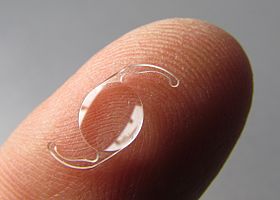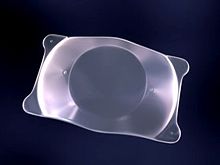| Intraocular lens | |
|---|---|
 A posterior chamber IOL (with haptics) | |
| ICD-9-CM | 13.72 |
| MeSH | D054120 |
| OPS-301 code | 5-984 |

An intraocular lens (IOL) is a lens implanted in the eye usually as part of a treatment for cataracts or for correcting other vision problems such as short sightedness and long sightedness; a form of refractive surgery. If the natural lens is left in the eye, the IOL is known as phakic, otherwise it is a pseudophakic lens (or false lens). Both kinds of IOLs are designed to provide the same light-focusing function as the natural crystalline lens.[1] This can be an alternative to LASIK, but LASIK is not an alternative to an IOL for treatment of cataracts.
IOLs usually consist of a small plastic lens with plastic side struts, called haptics, to hold the lens in place in the capsular bag inside the eye.[2] IOLs were originally made of a rigid material (PMMA), although this has largely been superseded by the use of flexible materials, such as silicone. Most IOLs fitted today are fixed monofocal lenses matched to distance vision. However, other types are available, such as a multifocal intraocular lens that provides multiple-focused vision at far and reading distance, and adaptive IOLs that provide limited visual accommodation. Multifocal IOLs can also be trifocal IOLs or extended depth of focus (EDOF) lenses.
As of 2021, nearly 28 million cataract procedures take place annually worldwide. That is about 75,000 procedures per day globally.[3] The procedure can be done under local or topical anesthesia with the patient awake throughout the operation. The use of a flexible IOL enables the lens to be rolled for insertion into the capsular bag through a very small incision, thus avoiding the need for stitches. This procedure usually takes less than 30 minutes in the hands of an experienced ophthalmologist, and the recovery period is about 2–3 weeks. After surgery, patients should avoid strenuous exercise or anything else that significantly increases blood pressure. They should visit their ophthalmologists regularly for 3 weeks to monitor the implants.
IOL implantation carries several risks associated with eye surgeries, such as infection, loosening of the lens, lens rotation, inflammation, nighttime halos and retinal detachment.[4] Though IOLs enable many patients to have reduced dependence on glasses, most patients still rely on glasses for certain activities, such as reading. These reading glasses may be avoided in some cases if multifocal IOLs, trifocal IOLs or EDOF lenses are used.[5][6][7]
- ^ Güell JL, Morral M, Kook D, Kohnen T (November 2010). "Phakic intraocular lenses part 1: historical overview, current models, selection criteria, and surgical techniques". Journal of Cataract and Refractive Surgery. 36 (11): 1976–93. doi:10.1016/j.jcrs.2010.08.014. PMID 21029908. S2CID 23014138.
- ^ Sanders D, Vukich JA (December 2006). "Comparison of implantable collamer lens (ICL) and laser-assisted in situ keratomileusis (LASIK) for low myopia". Cornea. 25 (10): 1139–46. doi:10.1097/ICO.0b013e31802cbf3c. PMID 17172886. S2CID 19435692.
- ^ Cite error: The named reference
Lindstrom 2021was invoked but never defined (see the help page). - ^ Cite error: The named reference
Statpearlswas invoked but never defined (see the help page). - ^ Cite error: The named reference
Zamorawas invoked but never defined (see the help page). - ^ Cite error: The named reference
de Silva et al 2016was invoked but never defined (see the help page). - ^ Cite error: The named reference
Kohnen and Suryakumar 2022was invoked but never defined (see the help page).